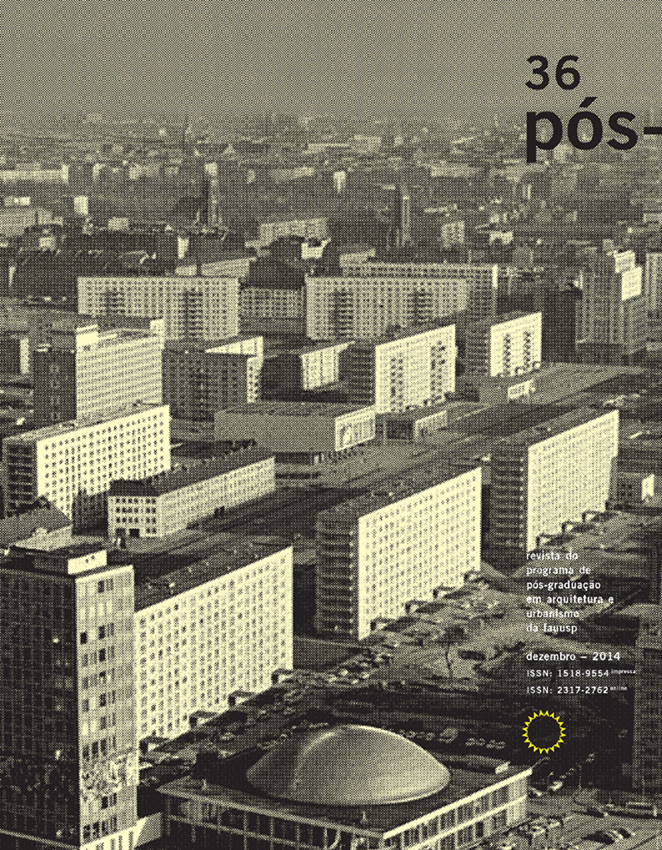Errar é urbano. Para uma hodologia de Lisboa
DOI:
https://doi.org/10.11606/issn.2317-2762.v21i36p102-123Palavras-chave:
Mobilidade urbana. Automóveis. Espaço público. Lugar. Caminhar. Tecnologia. Urbanismo. Lisboa.Resumo
O artigo apresenta a genealogia histórica do favorecimento do automóvel na cidade e as mudanças concomitantes no urbanismo, na pedonalidade e na criação e preservação de lugares, salutares para o exercício da cidadania. Pretende-se demonstrar que a adoção generalizada da automobilidade, enquanto tecnologia de impacte múltiplo e pernicioso, afectou uma metodologia geral de configuração do espaço; provocou igualmente uma erosão do caminhar e do sentido de lugar, nos centros históricos de várias cidades europeias, sacrificando as necessidades dos peões e a convivialidade das ruas e do espaço público. Na primeira parte, por razões de acessibilidade aos arquivos da Hemeroteca, escolhemos expor o estudo de caso de Lisboa, ilustrando como o poder político e os urbanistas se aliaram, para modificar a cidade, valorizando o papel das demolições e do automóvel, como cura para males sociais. A nossa análise centrar-se-á na génese do Código da Estrada e nos discursos do órgão oficial do Automóvel Clube de Portugal (ACP) e de revistas da época, os quais documentam as transformações ocorridas no centro histórico da Lisboa de meados do século 20. Na segunda parte, através de uma análise fenomenológica, examinamos como o caminhar e a condução motorizada constituem o mundo de diferentes modos; cada um promove assim um acesso diferenciado às qualidades da cidade, justificando uma perspectiva própria na percepção e ação na forma urbana, adotada pelos habitantes da cidade e por urbanistas. Concluímos tecendo algumas considerações sobre os efeitos da automobilidade na vida urbana, ao se tornar um pressuposto tácito no urbanismo; o espaço público é progressivamente convertido em estacionamento, nós viários, semáforos e passadeiras; os peões, por sua vez, veem os seus gestos, hábitos e comportamentos domesticados e negligenciados; a pedonalidade em Portugal passou assim a ser social, política e tecnicamente invisível, de acordo com os modelos científicos e técnicos da automobilidade.
Downloads
Referências
ACP – Revista de Turismo e Automobilismo. 5, Lisboa: ACP, 1939.
ACP – Revista de Turismo e Automobilismo. 3, Lisboa: ACP, 1941
ACP – Revista de Turismo e Automobilismo. 7, Lisboa: ACP, 1941.
ACP – Revista de Turismo e Automobilismo. 3, Lisboa: ACP, 1942.
BERLEANT, Arnold. Living in the Landscape. Kansas: University Press of Kansas, 1997.
BÔLE-RICHARD, Aymeric. Pedonalidade no Largo do Rato. Micropoderes. Lisboa: ACA-M, 2008.
CARERI, Francesco. Walkscapes – Camminare Como Pratica Estetica. Roma: Einaudi, 2006.
FRANÇA, José Augusto. Lisboa, História Física e Moral. Lisboa: Horizonte. 2008.
FERNANDES, José Manuel. Ressano Garcia e as Avenidas: Dimensões. Lisboa de Frederico Ressano Garcia: 1874-1909, p. 39-41. Lisboa: C.M.L, 1989.
FERNANDES, José Manuel. Lisboa em Obra(s). Lisboa: Livros Horizonte, 1997.
DIAS, Marina Tavares. Lisboa Desaparecida. Lisboa, Quimera, 1987.
DIAS, Marina Tavares. Lisboa nos anos 40: longe da guerra. Lisboa, Quimera, 1997.
FLINK, James. The Car Culture. Boston: MIT Press, 1976.
HALLSTEN, Johanna, 2005. Movement and Participation: Journeys within Everyday Environments, Contemporary Aesthetic Journal – Aesthetics and Mobility, Special Volume, 1, 2005. Disponível em: http://hdl.handle.net/2027/spo.7523862.spec.111. Acesso em: 10 out. 2013.
ILLICH, Ivan. Energy and Equity. London: Marion Boyars Publisher, 1979.
LEFEBVRE, Henri. O Direito à Cidade. Lisboa: Letra Livre, 2012.
LÔBO, Margarida Sousa. Planos de Urbanização: a Época de Duarte Pacheco. Porto: FAUP, 1995.
MANGORINHA, Jorge. Papéis de(o) Arquitecto na intervenção municipal urbana: notas sobre projectar Lisboa no séc. XX, Cadernos do Arquivo Municipal, n3, p. 216-227. Lisboa: C.M.L. 1999.
PALLASMAA, Juhani. The Eyes of the Skin: Architecture and the Senses. West Sussex: John Wiley & Sons, 1996.
NAUKKARINEN, Ossi. 2005, Aesthetics and Mobility – A Short Introduction into a Moving Field.
Contemporary Aesthetic Journal – Aesthetics and Mobility, Special Volume, 1, 2005. Disponível em: http://hdl.handle.net/2027/spo.7523862.spec.103. Acesso em 10 out. 2013.
RAMOS, Manuel João e ALVES, J. Mário (Org.). The Walker and the City. Lisboa: ACA-M, 2010. Revista Municipal. 2. Lisboa: C.M.L., 1939.
RAMOS, Manuel João e ALVES, J. Mário (Org.). Número Especial. Lisboa, C.M.L., 1943.
RAMOS, Manuel João e ALVES, J. Mário (Org.). 42. Lisboa, C.M.L., 1949.
RAMOS, Manuel João e ALVES, J. Mário (Org.). 55, Lisboa, C.M.L., 1952.
MARTINS, Rocha. Lisboa: História das suas glórias e catástrofes. Lisboa: Editorial Inquérito, 1947.
SEPANMAA, Yrjö. The Aesthetics of the Road, Road Art, and Road Traffic. Contemporary Aesthetics Journal – Aesthetics and Mobility, Special Volume, 1, 2005. Disponível em: http://hdl.handle.net/2027/spo.7523862.spec.109. Acesso em 10 out. 2013.
SILVA, Carlos Nunes. Política Urbana em Lisboa: 1926-1974. Lisboa: Livros Horizonte, 1994.
SOLNIT, Rebecca. Wanderlust: a History of Walking. London: Verso, 2001.
VERBEEK, Peter-Paul. Tecnopólis: a vida pública dos artefactos tecnológicos. Análise Social, p. 1105-1125, XLI, 4º trimestre. Lisboa: ICS, 2006.
Downloads
Publicado
Edição
Seção
Licença
O detentor dos direitos autorais é o autor do artigo. A revista exige apenas o ineditismo na publicação do artigo. O autor tem do direito de divulgar seu artigo conforme sua conveniência devendo citar a revista.
DIADORIM - Diretório de Políticas Editoriais












